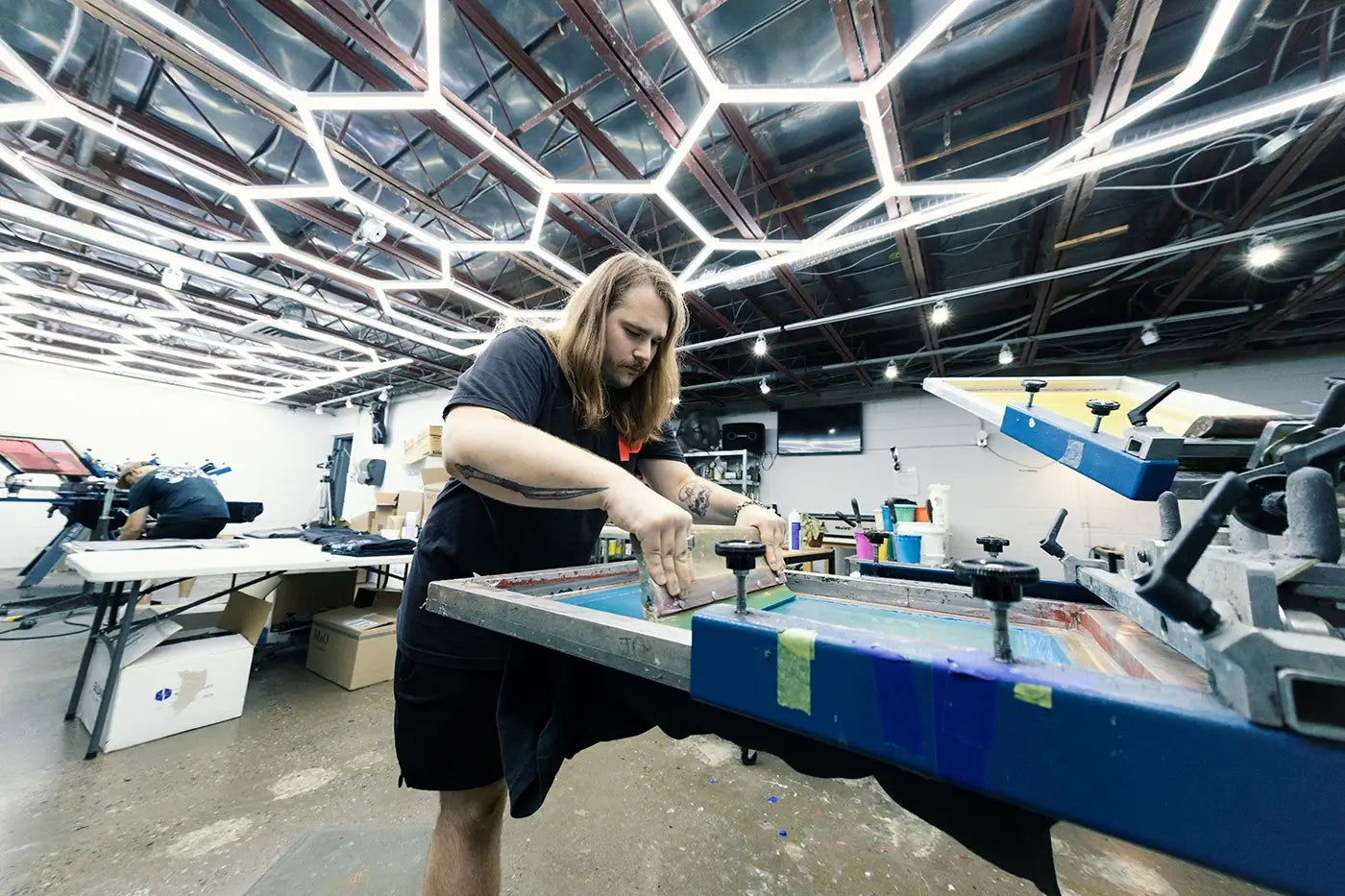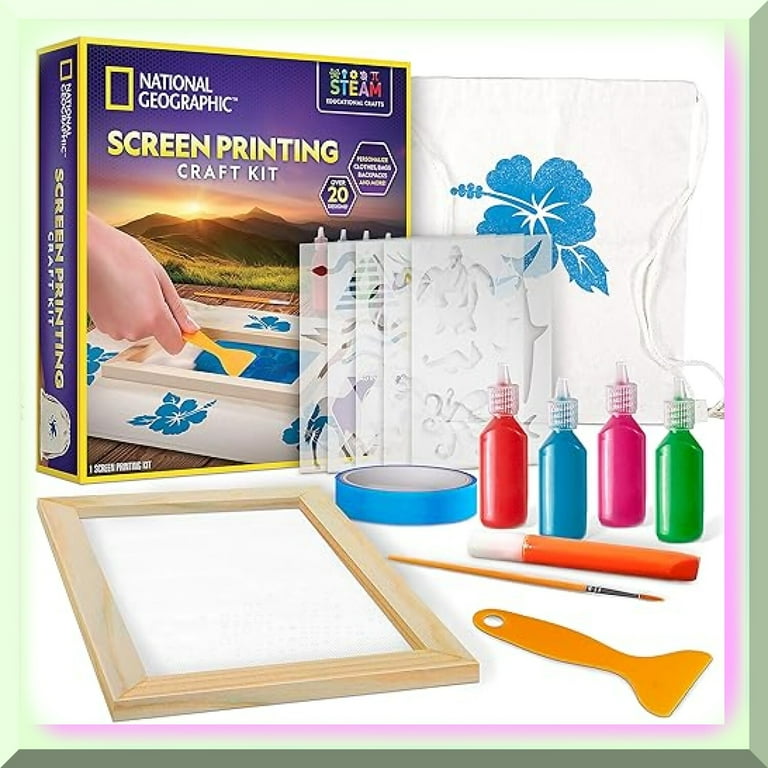High-Volume T-Shirt Printing for Schools and Organizations
High-Volume T-Shirt Printing for Schools and Organizations
Blog Article
Display Printing Uncovered: Whatever You Need to Know About T-Shirt and Garment Printing Techniques
If you have actually ever questioned how those vivid designs finish up on your favored tees, you're in the best place. Display printing is an interesting method that integrates art with method, supplying unlimited opportunities for imagination. Understanding the principles, from equipment to ink options, can considerably impact your outcomes. Ready to explore the vital components that make display printing an art kind? Allow's uncover the information that can boost your projects.
The Fundamentals of Screen Printing: How It Works
When you plunge into screen printing, you'll discover it's both an art and a science. At its core, display printing entails creating a stencil, or screen, that enables ink to pass via only in certain areas.
Following, you'll mix your inks and prepare your printing surface area. Position the screen over the fabric, then utilize a squeegee to press ink with the screen onto the garment. This process needs precision, as you desire clear, vivid prints. After printing, you'll treat the ink with heat, ensuring it sticks to the fabric and lasts via laundries. Each action is necessary, and grasping them will certainly elevate your screen printing abilities, changing basic garments into distinct, expressive pieces.
Sorts Of Screen Printing Methods
As soon as you comprehend the essentials of display printing, it's time to explore the numerous strategies that can elevate your layouts. One popular technique is conventional screen printing, where ink is pushed through a stenciled display. This strategy is fantastic for bold, dynamic colors. There's water-based ink printing, which supplies a softer feeling and is environmentally friendly, but it needs a different method to treating.
If you're aiming for great details, think about discharge printing. This technique gets rid of dye from the fabric, leaving a soft, classic appearance. One more alternative is plastisol printing, understood for its sturdiness and vivid shades, making it a favorite for many brands. Finally, trying out halftone printing to develop gradient results and elaborate styles. Each method has its special appeal, so don't think twice to try them out to discover what suits your design best!
Crucial Tools for Display Printing
To accomplish stunning lead to screen printing, having the right devices is essential. Initially, you'll require a tough screen printing frame, which holds the mesh that transfers your layout onto the garment. Next, buy top notch squeegees; these are vital for applying ink evenly throughout the screen. You'll likewise need a good direct exposure unit to produce your screens, along with a washout cubicle for cleaning them after usage. A reliable heat resource, like a conveyor dryer or warmth press, is critical for curing your prints to assure durability. Don't neglect a proper office, geared up with tables and storage space for your products. Ultimately, safety gear, such as handwear covers and masks, will certainly maintain you secure from chemicals and inks. With the right devices, you'll be well on your way to creating professional-quality prints.
Choosing the Right Inks and Materials
When choosing inks and materials for screen printing, you require to consider the type of ink that works finest for your project. Believe about material compatibility to guarantee your styles look last and great lengthy. Discover eco-friendly ink options to make your printing procedure extra lasting.
Kinds Of Screen Inks
Selecting the appropriate display ink is necessary for achieving dynamic, sturdy prints that meet your task's demands. There are several types of display inks to analyze. Specialized inks, such as glow-in-the-dark or metallic, can include unique impacts to your layouts.

Textile Compatibility Considerations
Comprehending fabric compatibility is crucial for achieving high-grade display prints, particularly since different products react uniquely to various inks. When picking inks, think about the fabric kind-- cotton, polyester, or blends. For cotton, water-based inks work well, using soft qualities and breathability. Polyester, on the other hand, often calls for plastisol inks for better bond and lively colors. If you're printing on blends, you may need to make use of a mix of both kinds. Always test your inks on example textile to ensure they adhere appropriately and keep color integrity. Furthermore, remember that textile weight and appearance can affect the last result, so choosing the appropriate ink and material combination is essential for your project's success.
Eco-Friendly Ink Options
Environment-friendly inks are ending up being a popular option for display printers who want to decrease their environmental effect while maintaining high quality. When picking inks, take into consideration water-based inks, which are less damaging and less complicated to clean up contrasted to conventional solvents.
In addition, try to find inks made from renewable energies, such as soy or vegetable-based alternatives. By choosing the ideal inks and materials, you'll not just produce spectacular layouts but also add to an extra lasting printing process. Make the button, and your prints will reflect your dedication to the setting!
Preparing Your Layout for Display Printing

File Layout Requirements
To ensure your layout looks vibrant and sharp on material, you'll need to pay close attention to submit style needs for screen printing. Make certain your design has a clear history to avoid unwanted white edges on your prints. Keep color settings in mind; CMYK is conventional for display printing, so transform your RGB designs accordingly.
Shade Separation Strategies
Shade splitting up is a vital step in preparing your style for screen printing, and mastering it can substantially boost your print high quality. You'll require to damage your style right into specific colors, as each color requires a separate screen throughout printing. Begin by recognizing all the colors in your design and develop layers for each one. You can use software application like Adobe Photoshop or Illustrator to isolate and separate shades properly. Be specific to conserve each layer as a separate file, usually in a format like TIFF or PSD. This precision not only guarantees precise color representation however additionally improves the printing procedure. By paying attention to color separation, you'll accomplish expert and vivid outcomes in your screen-printed garments.
Resolution and Dimension
Attaining the ideal lead to screen printing starts with ensuring your design has the best resolution and dimension. Ideally, your artwork must be at least 300 DPI (dots per inch) for sharp, clear prints. Your final item might look unprofessional and pixelated. if you use reduced resolution.
When it involves dimension, take into consideration the dimensions of your print area. Design your art work to match the last print dimension, preferably developing it in the real dimensions you'll be publishing. This method, you'll stay clear of any type of unforeseen scaling problems.
Always check your design in both vector and raster formats. Vector graphics can be scaled without shedding high quality, making them excellent for display printing. Preparing appropriately will assure your design looks fantastic on every garment!
Step-by-Step Display Printing Refine
Screen printing is a vibrant procedure that permits you to develop dynamic styles on different surfaces. To get begun, you'll require a display, emulsion, and your selected ink.
After rinsing the unexposed solution, your screen is prepared. Establish it up on your printing surface and align your garment below it. Put ink onto the display and use a squeegee to press the ink through the pattern onto the textile. Raise the screen carefully and let the print completely dry. Treat the ink using warm to guarantee sturdiness. That's it! You have actually successfully display published your style.
Tips for Successful Display Printing Projects
While you're diving into your display printing projects, keep in mind that preparation is vital to success. Begin by collecting all your materials-- inks, screens, mops, and garments. A clean work space aids stop undesirable errors, so clean prior to you start.
Next, verify your artwork is high-resolution and properly sized for your garment. Evaluate your screen for correct exposure and tidy it completely to avoid smudges. When mixing your inks, comply with the producer's standards to achieve the ideal uniformity.
Throughout printing, use even stress with your squeegee for constant outcomes. Do not hurry; take your time to confirm each print fulfills your criteria. After printing, allow your garments completely dry totally before managing or packaging them.
Lastly, constantly maintain a sample of your job for future recommendation. By doing this, you can analyze your development and enhance your strategies over time. Pleased printing!

Regularly Asked Inquiries
The length of time Does It Require To Set up a Display Printing Task?
Establishing a display printing work typically takes around 30 mins to an hour. You'll prepare the displays, mix inks, and adjust the press. The time differs based on intricacy and experience, so remain arranged!
Can I Publish on Various Material Types Using the Exact Same Strategy?
Yes, you can print on various fabric kinds utilizing the exact same strategy, yet you'll need to change your settings and inks. Some textiles absorb ink in different ways, so exploring warranties the very best outcomes for every product.
What Are Usual Mistakes to Stay Clear Of in Display Printing?
When screen printing, prevent usual errors like using the wrong ink, neglecting appropriate exposure times, or avoiding pre-press checks. Constantly evaluate your setup and maintain tidy screens to ensure high quality outcomes each time.
Exactly How Can I Appropriately Tidy and Preserve My Display Printing Equipment?
To properly clean and preserve your screen printing tools, you ought to regularly wash screens with proper solvents, examine mops for wear, and guarantee all devices are saved dry and dust-free. Consistency enhances and protects against pricey repairs efficiency.
Is Display Printing Environmentally Pleasant Compared to Various Other Approaches?
Display printing can be much more environmentally pleasant than various other approaches, specifically if you utilize eco-conscious materials and water-based inks. By choosing lasting products and techniques, you reduce waste and lessen your influence on the world.
Screen Printing Uncovered: Everything You Required to Know Concerning T-Shirt and Garment Printing Strategies
At its core, display printing entails creating a pattern, or screen, that enables ink to pass t-shirt printing via only in certain areas. Position the screen over the material, then utilize a squeegee to push ink via the screen onto the garment. One popular approach is conventional screen printing, where ink is pushed via a stenciled screen.When picking inks and products for screen printing, you require to take into account the kind of ink that functions finest for your job.
Report this page